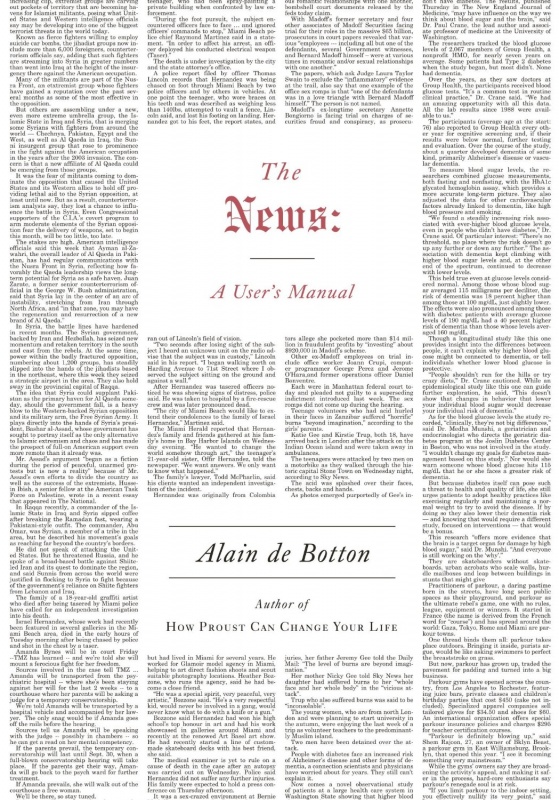22 Jul / The News: A User’s Manual by Alain de Botton

 Alain de Botton has a book I might never ever read – the one that happens to have a little note inscribed to me from de Botton himself, courtesy of a dear friend who met him in London and shipped the volume across the Pond. Truth be told, that book has sat prominently on my shelves for eight years already. Because obsessive groupie that I am, I must keep a de Botton title on reserve, savoring the possibility of instant delight; I literally (ha!) can’t bear the thought of no more de Botton.
Alain de Botton has a book I might never ever read – the one that happens to have a little note inscribed to me from de Botton himself, courtesy of a dear friend who met him in London and shipped the volume across the Pond. Truth be told, that book has sat prominently on my shelves for eight years already. Because obsessive groupie that I am, I must keep a de Botton title on reserve, savoring the possibility of instant delight; I literally (ha!) can’t bear the thought of no more de Botton.
Thank goodness his new titles appear on a fairly regular basis. This, his latest, which hit shelves last February, is one of my most scrawled-over galleys ever. Do I agree with everything he writes? Of course not. But as intractable as I am, de Botton challenges me to think beyond my comfort zones, inducing a jarring blend of gasps and giggles, shock and guffaws (no writer does better truth-inspired snark) from page to page. The News is especially adept at eliciting extreme reactions.
The book, de Botton explains, “is an exercise in trying to make this ubiquitous and familiar habit” – checking the news – “seem a lot weirder and rather more hazardous than it does at present.” Beyond the classroom, “news is the teacher … the prime creator of our political and social reality.” The news is ultimate power: “… if you want to change the mentality of a country, you don’t head to the art gallery, the department of education or the homes of famous novelists; you drive the tanks straight to the nerve centre of the body politic, the news HQ.” With our instant, insistent access to the news, escape is virtually impossible. “We may need some help with what the news is doing to us: with the envy and the terror, with the excitement and the frustration, with all that we’ve been told and yet occasionally suspect we may be better off never having learnt.” Help is here.
Divided into “a set of encounters,” de Botton – as he is seemingly effortlessly wont to do – organizes major ideas into distilled segments, from politics to economics to celebrity and more. Pithy gems (to nod with or argue against) are constant and, of course, best discovered and chosen at each reader’s will. [In case you’re debating consumption methods, de Botton’s titles are inarguably better on the page: his visuals – News even includes a “Photography” chapter – are as important as the text.]
Need a few enticements to open the book for yourself? Political coverage panders to immediate partial gratification rather than providing comprehensive understanding. Budget problems in the Italian government will probably not slow our channel-surfing, and yet we will go way out of our way to witness the fraught history of Roman leadership in Shakespeare’s Julius Caesar. Today’s archetypal famous person was driven for such recognition as a direct reaction to early rejection. “Everything out there (the trees, our spouse, the office) is, at heart, [made up of] … a mere 118 elements.” From profundity to psycho-babble, de Botton enlightens, entertains, entices, and occasionally annoys. Whatever your ultimate reaction by book’s end, we’re talking major energetic engagement throughout. When’s the last time you exercised your brain quite like that?
Tidbit: Watch Alain charm an enormous audience in Sydney … you won’t find 43 archetypes, St. Natalie of the Playground, news outlets learning bias from top chefs, insomnia as payback, Philosophers Mail (and more) in the book. Well worth a watch/listen. No one does erudite snark and human improvement (no, that’s not contradictory) better than de Botton.
Readers: Adult
Published: 2014
